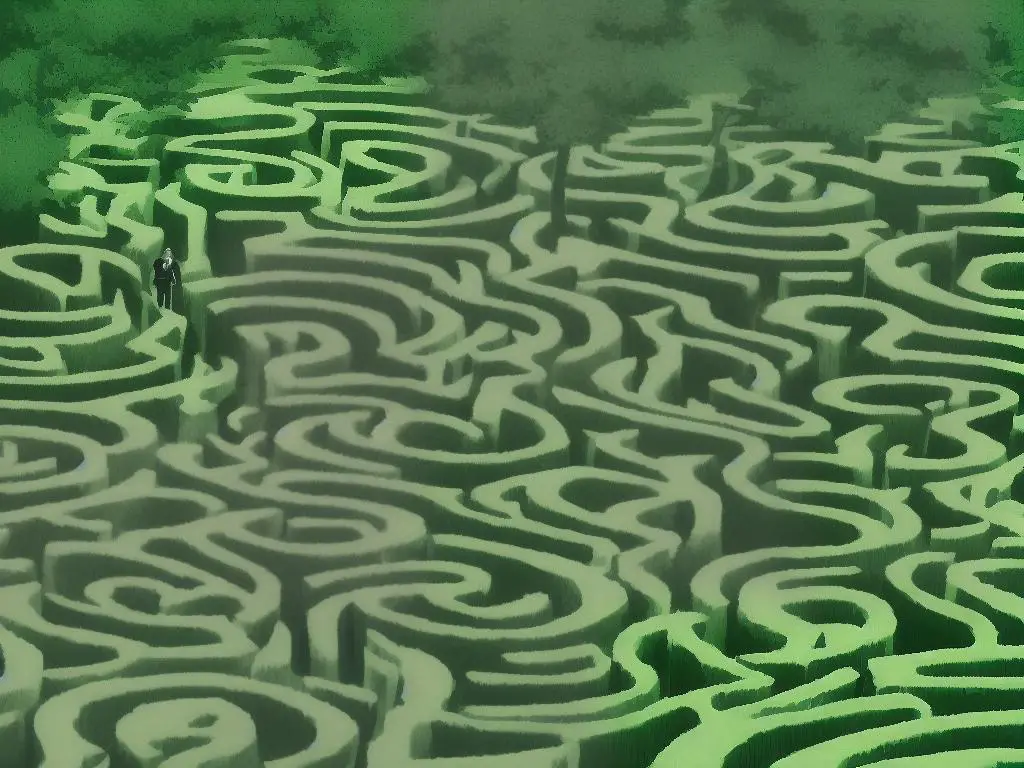Imagine the disorientation and unease that arises when navigating through an endless labyrinth with no clear exit in sight. Dreams of being trapped in a maze can evoke feelings of confusion, helplessness, and entrapment, leading one to wonder about the deeper meaning and significance of such an experience. This essay delves into various aspects of trapped-in-maze dreams, from interpreting their symbolic meanings and analyzing the metaphoric representation of mazes in history and culture, to exploring potential personal factors that trigger these dreams, and providing practical advice on how to cope with and even overcome them through techniques such as lucid dreaming.
Interpreting Trapped-in-Maze Dreams
Understanding Trapped-in-Maze Dreams
Dreams about being trapped in a maze are quite common and can be loaded with various emotions, such as confusion, disorientation, and helplessness. In order to better understand these dreams, it’s essential to delve into the symbolism and themes that commonly appear in trapped-in-maze dreams and explore potential psychological interpretations.
Symbolism and Themes
A maze is a complex network of paths and hedges designed to disorient and confuse those who enter it. As a dream symbol, a maze can represent many things, including the brain, the subconscious mind, or a puzzling life situation. Some common themes in trapped-in-maze dreams include:
- Feeling lost and confused: In a maze, it is easy to become lost and disoriented. This feeling may symbolize your current life situation, where you feel perplexed about which direction to take.
- Helplessness: The inability to find your way out of the maze indicates feelings of powerlessness and helplessness that you may be experiencing in waking life.
- Obstacles and challenges: The constant twists and turns in a maze symbolize unforeseen challenges and obstacles that you might be facing in your waking life.
- Decision-making and choice: As you navigate through the maze, you are constantly presented with multiple paths and choices. This theme could symbolize a difficult decision you must make in real life.
- Transformation and personal growth: Successfully navigating through the maze and finding your way out may represent overcoming challenges and achieving personal growth.
Psychological Interpretations
According to dream experts and psychologists, trapped-in-maze dreams can be interpreted in various ways:
- Carl Jung’s perspective: Swiss psychiatrist Carl Jung believed that dreams were a way for our psyche to convey important messages to our conscious mind. From Jung’s perspective, a trapped-in-maze dream may symbolize the individual’s struggle to find their true self and overcome inner conflicts. The maze may represent the labyrinth of the unconscious mind, with its intricate ways leading the dreamer toward self-awareness and individuation.
- Sigmund Freud’s perspective: On the other hand, Freud, the father of psychoanalysis, would argue that a trapped-in-maze dream symbolizes the dreamer’s repressed emotions and desires. The maze metaphor may represent the dreamer’s unconscious efforts to navigate through their suppressed feelings, seeking a way to express or resolve them.
- Cognitive theories: Cognitive theories of dream interpretation view these dreams as a mental simulation of problem-solving. In this case, a trapped-in-maze dream would suggest that the dreamer is facing a complex issue in their waking life and using the cognitive skills acquired during REM sleep to explore potential solutions.
Conclusion
Regardless of the specific theory, most psychologists agree that dreams involving being trapped in a maze often represent feelings of confusion, helplessness, and the need to make decisions amid uncertainty. It is crucial for the dreamer to pay attention to the emotions experienced during the dream and identify potential connections to their waking life. In doing so, they can gain valuable insights into their mental and emotional state, as well as potential solutions to the problems they face.

Analyzing the Maze as Metaphor
The Origin of the Maze as a Metaphor
Understanding the symbolism of mazes can help illuminate the meanings behind these dreams. The concept of the maze has roots in ancient history and mythology. Labyrinths, a type of maze, have been discovered in various cultures, including ancient Greece, Egypt, and Native American cultures. One of the earliest and most famous examples of a labyrinth is the myth of the Minotaur in Greek mythology, where Theseus entered the labyrinth to defeat the half-man, half-bull creature. These early labyrinths were not only physical structures but also served as metaphors for life’s challenges, personal growth, and self-discovery. As such, dreams of being trapped in a maze might serve as a subconscious reminder of the need to confront and navigate life’s complexities and uncertainties.
The Use of Maze in Literature
The utilization of the maze as a metaphor has been prevalent in literature from ancient times to the present day. In Dante Alighieri’s “The Divine Comedy,” the journey through Hell, Purgatory, and Heaven can be seen as a complex maze the protagonist must navigate to reach redemption. Similarly, in Franz Kafka’s “The Trial,” the protagonist is trapped in a bureaucratic maze, symbolizing the dehumanizing and infinite nature of modern society.
Contemporary literature continues to make use of the maze metaphor, such as in Mark Z. Danielewski’s “House of Leaves,” where the discovery of a labyrinthine and continually changing space within a home becomes an allegory for the protagonist’s psychological unraveling. The Maze Runner, a popular young adult series by James Dashner, also employs the metaphor, with the characters literally trapped in a maze as they search for an escape and uncover hidden truths about their world.
Psychological Implications of the Maze
The maze serves as a potent metaphor because it symbolizes our primal fears, desires, and subconscious thoughts. On one level, the maze represents a sense of confinement and entrapment, where individuals strive to break free from limitations and find their path to freedom. Additionally, it can signify the search for identity and self-understanding, as characters often journey through the maze with the hope of discovering who they are or the meaning of their existence.
In dream analysis, the sensation of being trapped in a maze can stem from feelings of confusion, uncertainty, or a lack of direction in one’s waking life. The maze may represent a complex problem or situation that the dreamer is struggling to navigate. The emotions experienced while lost in the maze indicate the dreamer’s psychological state; frustration may represent the inability to find a solution, while finding the exit may signify personal growth or a newfound understanding of the problem.
Relating to the modern world, the maze metaphor has grown to encompass not only physical confinement but also feelings of being lost within the complexities of social and political structures, unable to find a sense of belonging or escape from societal pressures.
Introduction to Maze Dreams
Throughout various cultures and mythological traditions, the metaphor of a maze carries a rich history and significance. It often represents the universal human experience of grappling with complex challenges, both internal and external, as we journey through life in search of meaning and self-discovery. Its psychological importance underscores the human propensity for feeling trapped and confined within different arenas of life, encompassing personal frustrations and societal implications. Dreams of being trapped in a maze, then, can provide powerful insights into an individual’s waking world, reflecting the complexities and challenges we all face on our life’s journey.

Personal Factors behind Maze Dreams
Psychological Interpretation of Maze Dreams
Dreams in which individuals find themselves trapped in labyrinth-like environments, commonly known as maze dreams, can be bewildering and unnerving experiences. However, they can also offer valuable perspectives on a person’s thoughts, emotions, and circumstances in real life. To understand the personal root causes behind trapped-in-maze dreams, it’s essential to explore various life situations, stressors, and internal conflicts that might trigger these types of dreams. By analyzing such dreams, one may uncover critical aspects of their life that may need attention or resolution, ultimately helping them navigate the intricate maze of life more effectively.
Life Situations and Stressors
One of the most common reasons for having a dream of being trapped in a maze is feeling overwhelmed or trapped in a specific situation in one’s waking life. This may be due to external factors, such as job-related stress, challenging family dynamics, or difficult personal relationships. Navigating the complexities of these situations can lead to feelings of confusion, helplessness, and the sensation of being trapped – emotions that often manifest themselves in maze dreams.
Another possible stressor contributing to maze dreams is the feeling of having too many choices or decisions to make. The maze in the dream may symbolize the many paths and options available, which can result in feelings of anxiety and indecision. This often arises during significant life transitions, such as determining one’s career path or choosing a long-term partner.
Internal Conflicts
Maze dreams can also stem from unresolved internal conflicts or emotional struggles that someone might be grappling with in their daily lives. Dreams of being trapped in a labyrinth may represent a subconscious attempt to work through these challenges, as the mind attempts to navigate and ultimately escape the maze.
One common internal conflict that could lead to maze dreams is feeling torn between two competing desires or priorities. This could be a personal dilemma, such as choosing between personal ambitions and family obligations, or it might be an emotional conflict, such as wrestling with feelings for two different romantic partners. In either case, the maze serves as a metaphor for the internal struggle to make sense of these opposing forces.
Another internal conflict that could give rise to maze dreams is the need for personal growth or change. Sometimes, an individual may feel stuck in a rut and yearn for transformation but may not know which direction to take. In this scenario, the maze may symbolize the internal pathways that one must navigate to break free from the restricting patterns in their life.
Emotional State
One’s emotional state plays a crucial role in determining the content and tone of their dreams, and this is no different for maze dreams. Those who experience anxiety, depression, or other emotional challenges may be more likely to have dreams of being trapped in a labyrinth, as these feelings can make everyday life seem like a maze of challenges that are difficult to overcome.
In particular, individuals with anxiety may find themselves trapped in repetitive, negative thought patterns, which can manifest as a confusing and endless maze within the dream world. In this case, the dreamer may be experiencing an amplified version of their worries, which serves as a reflection of their anxieties in waking life.
Introduction to Lucid Dreams and Maze Dreams
Lucid dreaming is a fascinating phenomenon in which the dreamer becomes aware that they are dreaming and can potentially exert control over the dream environment, characters, and events. This type of dreaming has been the subject of much research, yielding suggestions that it offers psychological benefits such as reducing anxiety and improving problem-solving skills.
Maze dreams are a specific type of nightmare where the dreamer finds themselves trapped within a complex, confusing maze with seemingly no way out. These dreams often evoke feelings of fear, frustration, and helplessness. They might be indicative of the dreamer’s anxiety, stress, or challenges faced in waking life and could hold valuable insights into the dreamer’s mindset.

Photo by john_thng on Unsplash
Lucid Dreaming and Maze Dreams
Understanding the Meaning of Maze Dreams
To truly comprehend the significance of being trapped in a maze during a dream, it’s essential to consider the various factors that might contribute to it. Challenging life circumstances, stressors, unresolved internal conflicts, and emotional struggles can all be potential triggers for a maze dream. While these dreams can be unnerving, understanding the possible personal reasons behind them can offer valuable insights into the dreamer’s life and mindset.
By examining these factors and considering the metaphorical nature of maze dreams, the dreamer can begin to gain a clearer understanding of their subconscious thoughts and feelings. Applying this newfound knowledge can help them address and resolve their waking-life challenges, ultimately leading to personal growth and a better-equipped approach to overcoming life’s obstacles.
The Potential Benefits of Lucid Dreaming in Overcoming Maze Dreams
Lucid dreaming can offer a unique opportunity for individuals who experience maze dreams to confront and potentially overcome the fear and anxiety associated with these nightmares. By achieving and maintaining lucidity during a dream, the dreamer can take control and explore the maze with the knowledge that what they’re experiencing is not real and that they can eventually wake up.
Through this exploration, lucid dreamers may gain insight into the meaning behind the mazes and the emotions tied to them, enabling them to address any unresolved issues or emotions in their waking lives. As a result, lucid dreaming has the potential to decrease the frequency and intensity of maze dreams, offering relief from the distress they may cause.
Techniques for Achieving and Maintaining Lucidity in Dreams
- Reality testing: Regularly question whether you are dreaming during the day by performing simple tests, such as trying to push your finger through the palm of your hand or attempting to read text. These habits may carry over into dreaming, increasing the likelihood of recognizing that you are in a dream.
- Dream journaling: Record your dreams daily to improve your dream recall, which can help you become more familiar with your dream themes and patterns, making lucid dreaming more likely.
- Wake back to bed method: Set an alarm to wake up during the night, stay awake for a short period, and then go back to sleep with the intention of becoming lucid in your next dream.
- Mnemonic Induction of Lucid Dreams (MILD): As you drift off to sleep, repeat a mantra to yourself affirming your intention to become lucid in your dreams, such as “Next time I’m dreaming, I will remember that I’m dreaming.”
- Visualization: Before falling asleep, visualize a recent dream you’ve had and imagine becoming lucid within that dream. This can help condition your mind to become lucid during actual dreams.
Overcoming Trapped-in-Maze Nightmares through Lucidity
For those experiencing frequent trapped-in-maze dreams, lucid dreaming can be a powerful tool for confronting and resolving the emotions and issues driving these nightmares. By becoming aware of their dream state, individuals can explore their environment, face any obstacles within the maze, and attempt to decipher the underlying message behind their experience. Approaching the dream with curiosity and levity can enable them to see the maze as a puzzle, making it easier to navigate and escape.
Developing and practicing lucidity-inducing techniques not only allows dreamers to better overcome their trapped-in-maze nightmares but also provides potential relief from the anxiety and fear they may cause. Mastering control over their dreams can empower individuals to confront their emotions and navigate through their subconscious maze.

Coping with Maze Dreams
Interpreting and Addressing Maze Dreams
Trapped-in-maze dreams often represent feelings of being stuck, confused, or cornered in certain life situations, as well as having difficulty in decision-making. Stress, anxiety, and unresolved issues in waking life may contribute to the occurrence of these dreams. In order to understand and cope with these nightmares, it is crucial to analyze their root cause and devise practical strategies to address the real-life concerns they reflect.
Dream Journaling
One of the most effective ways to analyze and gain insights into your dreams is to keep a dream journal. Write down everything you can remember from your dream as soon as you wake up. Include specific details such as the setting, your emotions, different characters, and any symbols or patterns that you are able to recall. Review your journal regularly, looking for recurring themes, symbols, or situations that link to your trapped-in-maze dreams. This process can help you identify triggers that may be causing these dreams and help you uncover any underlying issues.
Stress Reduction
Stress is a common factor behind nightmares and difficult dreams. Incorporating stress-reducing activities in your daily life can help ease the frequency and intensity of trapped-in-maze dreams. Some effective stress-reducing practices include mindfulness meditation, yoga, exercise, and spending time in nature. Additionally, adopting healthy habits such as getting sufficient sleep, maintaining a balanced diet, and staying away from stimulants like caffeine and electronics before bedtime can improve your overall well-being and promote restful sleep.
Seeking Professional Help
If your trapped-in-maze dreams persist or become increasingly distressing, it might be helpful to consult a mental health professional such as a therapist or counselor. These professionals are trained to help you address and resolve underlying issues that may be causing your dreams. They can also provide coping strategies and techniques to manage stress and anxiety in your daily life, which may help prevent recurring nightmares.
Lucid Dreaming and Dream Control
Gaining control over your dream state, also known as lucid dreaming, can help you navigate through maze dreams more calmly and effectively. There are various techniques to enhance your ability to have lucid dreams, such as reality checks, mnemonic induction of lucid dreams (MILD), and wake-induced lucid dreaming (WILD). Once you become lucid in a dream, you can confront the maze, face any challenges it presents, and remind yourself that you are in a dream and have the power to navigate through it successfully.
Psychological Support
Surrounding yourself with a supportive network of friends and family is crucial in maintaining a healthy mental and emotional well-being. Sharing your dream experiences with them might provide you with insights and suggestions on how to deal with your trapped-in-maze dreams. Alternatively, joining a dream discussion group or online forum can help you connect with others who may have experienced similar dreams, allowing you to exchange advice, coping mechanisms, and strategies.
Conclusion
Overall, coping with maze dreams involves understanding their underlying causes, implementing stress reduction techniques, seeking professional help if needed, practicing lucid dreaming, and connecting with a supportive network of people. These strategies can collectively contribute to a healthier emotional state, empowering you to face, conquer, and even prevent trapped-in-maze dreams in the future.

As the journey to understanding one’s dreams is a personal and complex exploration, it is essential to approach the subject with an open mind and a willingness to delve into one’s own inner workings. By interpreting the message of trapped-in-maze dreams and identifying their underlying causes, individuals can embark on a path of self-discovery and personal growth. Moreover, by employing lucid dreaming techniques and incorporating coping strategies into daily life, individuals can master their maze dreams and transform them into empowering, enlightening experiences. So, the next time you find yourself lost in the winding corridors of your dreams, remember that you hold the key to unlocking the secrets of your personal labyrinth.
